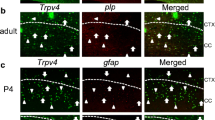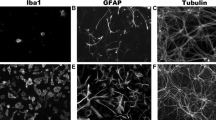Abstract
The ability of mature oligodendrocytes (OLs) to recover from insult is important in repair of damage following demyelination. Since regulation of Ca2+ levels within cells plays a critical role in function and survival, this study investigates the effects of changes in cytoplasmic Ca2+ on the viability of cultured mouse OLs and their ability to maintain membrane sheets. Mature OLs in culture respond rapidly to the calcium ionophore A23187 and promptly return to resting Ca2+ levels when the ionophore is removed. Longer exposure to 0.1–1.0 μM A23187 leads to microtubule disruption, membrane sheet retraction and eventual cell death; nuclear lysis occurs in many of the OLs, as reported by Scolding, et al. (1) for rat OLs. In our cultures, mature OLs were more susceptible to nuclear lysis than were immature OLs or astroglia. Release of intracellular Ca2+ stores with thapsigargin at 5–10 μM also leads to retraction of membrane sheets. Following 6 hours of continuous exposure to thapsigargin, the effects on membrane sheets are reversed over the next 12 hours. After 18 hours of continuous exposure to thapsigargin, only occasional nuclear lysis is observed, but a number of the mature OLs show signs of DNA fragmentation, indicating that apoptotic death is occurring. Our results suggest that mature OLs cannot survive a prolonged influx of extracellular calcium as readily as immature OLs and astroglia, but have mechanisms to withstand similar increases in cytoplasmic Ca2+ following sustained release of intracellular stores.
Similar content being viewed by others

References
Scolding, N. J., Morgan, B. P., Campbell, A. K., and Compston, D. A. S. 1990. The role of calcium in rat oligodendrocyte injury and repair. Neurosci. Lett. 135:95–98.
Smith, M. E. 1968. The turnover of myelin in the adult rat, Biochim. Biophys. Acta 164:285.
Smith, M. E. 1980. Biosynthesis of peripheral nervous system myelin proteins in vitro. J. Neurochem. 35:1183.
Smith, M. E., and Eng, L. 1965. The turnover of the lipid components of myelin. J. Am. Oil. Chem. Soc. 42:1013.
Benjamins, J. A., and Smith, M. E. 1984. Metabolism of Myelin. Pages 225–258,in P. Morell, (ed.), Myelin (2nd edition). Plenum Press, New York.
Smith, M. E., and Benjamins, J. A. 1984. Model systems for study of perturbations of myelin metabolism. Pages 441–487,in P. Morell, (ed.), Myelin (2nd edition). Plenum Press, New York.
Dyer, C. A., and Benjamins, J. A. 1988. Antibody to galactocerebroside alters organization of oligodendroglial membrane sheets in culture. J. Neurosci. 8:4307–4318.
Knapp, P. E., Bartlett, W. P., and Skoff, R. P. 1987. Cultured oligodendrocytes mimic in vivo phenotypic characteristics: cell shape, expression of myelin-specific antigens, and membrane production. Developmental Biology 120:356–365.
Wilson, R., and Brophy, P. J. 1989. Role for the oligodendrocyte cytoskeleton in myelination. J. Neurosci. Res. 22:439–448.
Dyer, C. A., and Benjamins, J. A. 1990. Glycolipids and transmembrane signaling: Antibodies to galactocerebroside cause an influx of calcium in oligodendrocytes. J. Cell Biol. 111:625–633.
Benjamins, J. A., and Nedelkoska, L. 1994. Maintenance of membrane sheets by cultured oligodendrocytes requires continuous microtubule turnover and golgi transport. Neurochem. Res. 19:631–639.
Scolding, N. J., Houston, W. A. J., Morgan, B. P., Campbell, A. K., and Compston, D. A. S. 1989. Reversible injury of cultured rat oligodendrocytes by complement. Immunology 67:441–446.
Jones, J., Frith, S., Piddlesden, S., Morgan, B. P., Compston, D. A. S., Campbell, A. K., Hallett, M. B. 1991. Imaging Ca2+ changes in individual oligodendrocytes attacked by T-cell perforin. Immunology 74:572–577.
Shirazi, Y., Rus, H. G., Macklin, W. B., and Shin, M. L. 1993. Enhanced degradation of messenger RNA encoding myelin proteins by terminal complement complexes in oligodendrocytes. J. Immunol. 150:4581–4590.
McCarthy, K. D., and Devellis, J. 1980. Preparation of separate astroglial and oligodendroglial cell cultures from rat cerebral tissue. J. Cell Biol. 85:890–902.
Bottenstein, J. E. 1986. Growth requirements in vitro of oligodendrocyte cell lines and neonatal rat brain oligodendrocytes. Proc. Natl. Acad. Sci. USA 83:1955–1959.
Deber, C. M., et al. 1985. Bromo-A23187: a nonfluorescent calcium ionophore for use with fluorescent probes. Anal. Biochem. 146:349–352.
Thastrup, O., Cullen, P. J., Drobak, B. K., Hanley, M. R., and Dawson, A. P. 1990. Thapsigargin, a tumor promoter, discharges intracellular Ca2+ stores by specific inhibition of the endoplasmic reticulum Ca2+-ATPase. Proc. Natl. Acad. Sci. USA 87:2466–2470.
Thastrup, O., Dawson, A. P., Scharff, O., Foder, B., Cullen, P. J., Drobak, B. K., Bjerrum, P. J., Christensen, S. B., and Hanley, M. R. 1989. Thapsigargin, a novel molecular probe for studying intracellular calcium release and storage. Agents and Actions 27: 17–23.
Schachner, M, Kim, S. K., and Zehnle, R. 1981. Developmental expression in central and peripheral nervous system of oligodendrocyte cell surface antigens (O antigens) recognized by monoclonal antibodies. Developmental Biology 83:328–338.
Sommer, I., and Schachner, M. 1981. Monoclonal antibodies (O1−O4) to oligodendrocyte cell surfaces: An immunocytological study in the central nervous system. Dev. Biol. 83:311–327.
Sommer, I., and Schachner, M. 1982. Cells that are O4 antigen positive and O1-antigen negative differentiate into O1 antigenpositive oligodendrocytes. Neurosci. Lett. 29:183–188.
Bansal, R., Stefansson, K., and Pfeiffer, S. E. 1992. Proligodendroblast antigen (POA), a developmental antigen expressed by A007/O4-positive oligodendrocyte progenitors prior to the appearance of sulfatide and glactocerebroside. J. Neurochem. 58: 2221–2229.
Bansal, R., Warrington, A. E., Gard, A. L., Ranscht, B., and Pfeiffer, S. E. 1989. Multiple and novel specificities of monoclonal antibodies O1, O4 and R-mAb used in the analysis of oligodendrocyte development. J. Neurosci. Res. 24:548–557.
Virtanen, I., Ekblom, P., and Laurila, P. 1980. Subcellular compartmentalization of saccharide moieties in cultured normal and malignant cells. J. Cell Biol. 85:429–434.
Tartakoff, A. M., and Vassalli, P. 1983. Lectin-binding sites as markers of Golgi sub compartment: Proximal-to-distal maturation of oligosaccharides. J. Cell Biol. 97:1243–1248.
Dyer, C. A., and Benjamins, J. A. 1991. Galactocerebroside and sulfatide independently mediate Ca2+ responses in oligodendrocytes. J. Neurosci. Res. 30:699–711.
Wing, M. G., Zajicek, J., Seilly, D. J., Compston, D. A. S., and Lachmann, P. J. 1992. Oligodendrocytes lack glycolipid anchored proteins which protect them against complement lysis. Restoration of resistance to lysis by incorporation of CD59. Immunology 76: 140–145.
Blankenfeld, G. V., Verkhratsky, A. N., and Kettenmann, H. 1992. Ca2+ channel expression in the oligodendrocyte lineage. Eur. J. Neurosci. 4:1035–1048.
Sontheimer, H., Trotter, M., Schachner, M., and Kettenmann, H. 1989. Channel expression correlates with differentiation stage during the development of oligodendrocytes from their precursor cells in culture. Neuron 2:1135–1145.
Wood, A., Wing, M. G., Benham, C. D., and Compston, D. A. S. 1993. Specific induction of intracellular calcium oscillations by complement membrane attack on oligodendroglia. J. Neurosci. 13: 3319–3332.
Smith, K. J., and Hall, S. M. 1994. Central demyelination induced in vivo by the calcium ionophore ionomycin. Brain 117:1351–1356.
Takeda, M., Nelson, D. J., and Soliven, B. 1995. Calcium signaling in cultured rat oligodendrocytes. Glia 14:225–236.
Berger, T., Schnitzer, J., Orkand, P. M., and Kettenmann, H. 1992. Sodium and calcium currents in glial cells of the mouse corpus callosum slices. Eur. J. Neurosci. 4:1277–1284.
Levick, V., Coffey, H., and D’Mello, S. R. 1995. Opposing effects of thapsigargin on the survival of developing cerebellar granule neurons in culture. Brain Res. 676:325–335.
Kirischuk, S., Scherer, J., Kettenmann, H., and Verkhratsky, A. 1995. Activation of P2-purinoreceptors triggered Ca2+ release from InsP3-sensitive internal stores in mammalian oligodendrocytes. J. Physiol. 483:41–57.
Pende, M., Holtzclaw, L. A., Curtis, J. L., Russell, J. T., Gallo, V. 1994. Glutamate regulates intracellular calcium and gene expression in oligodendrocyte progenitors through the activation of DL-alpha-amino-3-hydroxy-5-methyl-4-isoxazolepropionic acid receptors. Proc. Natl. Acad. Sci. USA 91:3215–3219.
Engle, J., Althaus, H. H., and Kristjansson, G. I. 1994. NGF increases [Ca2+]i in regenerating mature oligodendroglial cells. Neurochemistry 5:397–400.
Sanders, S. L., Whitfield, K. M., Vogel, J. P., Rose, M. D., and Schekman, R. W. 1992. Sec61p and BiP directly facilitate polypeptide translocation into the ER. Cell 69:353–365.
Hendershot, L. M. 1990. Immunoglobulin heavy chain and binding protein complexes are dissociated in vivo by light chain addition. J. Cell Biol. 111:829–837.
Resendez Jr., E., Ting, J., Kim, K. S., Wooden, S. K., and Lee, A. S. 1986. Calcium ionophore A23187 as a regulator of gene expression in mammalian cells. J. Cell Biol. 103:2145–2152.
Drummond, I. A. S., Lee, A. S., Resendez Jr., E., and Steubgardt, R. A. 1987. Depletion of intracellular calcium stores by calcium ionophore A23187 induces the genes for glucose-regulated proteins in hamster fibroblasts. J. Biol. Chem. 262:12801–12805.
Li, W. W., Alexandre, S., Cao, X., and Lee, A. S. 1993. Transactivation of the grp78 promoter by Ca2+ depletion. J. Biol. Chem. 268:12003–12009.
Author information
Authors and Affiliations
Additional information
Special issue dedicated to Dr. Marion E. Smith.
Rights and permissions
About this article
Cite this article
Benjamins, J.A., Nedelkoska, L. Release of intracellular calcium stores leads to retraction of membrane sheets and cell death in mature mouse oligodendrocytes. Neurochem Res 21, 471–479 (1996). https://doi.org/10.1007/BF02527712
Accepted:
Issue Date:
DOI: https://doi.org/10.1007/BF02527712



